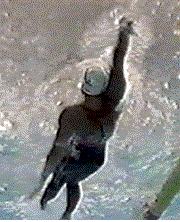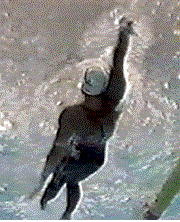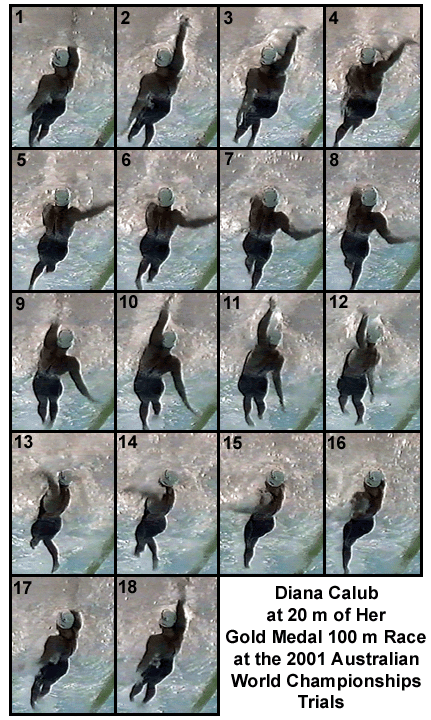

DYANA CALUB AT 20 m OF HER GOLD MEDAL 100 m BACKSTROKE RACE AT THE 2001 AUSTRALIAN WORLD CHAMPIONSHIPS TRIALS IN HOBART, TASMANIA
Each frame is .1 seconds apart. This sequence is from Dyana Calub's winning 100 m backstroke race at the 2001 Australian World Championship Trials held in Hobart, Tasmania. Her time for the event was 1:02.56 seconds.
This stroke analysis includes a moving sequence in real time, and a moving sequence where each frame is displayed for .5 of a second. There is a collage of still frames at the end of this analysis.The following image sequence is in real time. It will play through 10 times and then stop. To repeat the sequence, click the browser's "refresh" or "reload" button.

The following image sequence shows each frame for half a second. It will play through 10 times and then stop. To repeat the sequence, click the browser's "refresh" or "reload" button.

Notable Features
This sequence is presented because its aspect allows one to see some of the most common errors made in backstroke swimming.
What results from these inefficiencies is a large amount of drag resistance. An exaggerated amount of energy is required to overcome the increased resistance. Both resistance and energy requirements increase with swimming velocity. There comes a stage where resistance is of such a magnitude that the swimmer cannot generate any more force, or harness any more energy, to swim faster. When that stage is reached, the swimmer performs at terminal velocity and the only way of improving performance is to decrease resistance and/or improve the mechanics of propulsion. In the case of Dyana Calub, some options for improvement are
The above actions should reduce sway, and therefore, reduce resistance. The stronger, more direct force application should increase propulsive forces and efficiency. These factors should make it possible for Dyana Calub to improve her performances considerably.

Return to Table of Contents for this section.
